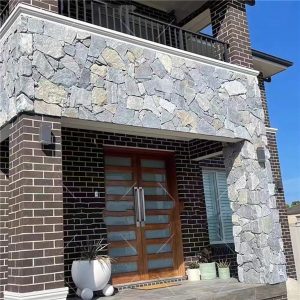Introduction
Stone veneer siding has become a popular choice for homeowners looking to enhance the aesthetic appeal and value of their homes. With its versatility, durability, and natural beauty, stone veneer siding offers a cost-effective alternative to traditional stone masonry while providing the same luxurious look and feel. In this comprehensive guide, we will explore the benefits, types, installation process, maintenance, and design ideas for stone veneer siding.
Benefits of Stone Veneer Siding
1. Aesthetic Appeal: Stone veneer siding adds a touch of elegance and sophistication to any home. With its natural textures and colors, it can mimic the look of authentic stone, creating a timeless and luxurious appearance.
2. Durability: Stone veneer siding is highly durable and can withstand harsh weather conditions, such as rain, wind, and snow. It is resistant to fading, chipping, and cracking, making it a long-lasting choice for homeowners.
3. Versatility: Stone veneer siding comes in a wide range of styles, colors, and textures, allowing homeowners to customize their exterior design to suit their personal preferences and architectural style.
4. Cost-Effective: Compared to traditional stone masonry, stone veneer siding is more affordable and easier to install. It offers the same look and feel of real stone at a fraction of the cost.
Types of Stone Veneer Siding
1. Natural Stone Veneer: Made from natural stone quarried from the earth, natural stone veneer offers an authentic and organic look. It is available in various types of stone, such as limestone, granite, and slate, each with its unique color and texture.
2. Manufactured Stone Veneer: Manufactured stone veneer, also known as faux stone or cultured stone, is made from a mixture of cement, aggregates, and iron oxides to mimic the appearance of natural stone. Stepping stone features for outdoor living is lightweight, easy to install, and more affordable than natural stone veneer.
3. Stacked Stone Veneer: Stacked stone veneer features irregularly shaped stones stacked together to create a rugged and rustic look. It is a popular choice for homeowners looking to add texture and depth to their exterior walls.
4. Brick Veneer: While not technically stone, brick veneer is a popular choice for homeowners seeking a classic and timeless look. Brick veneer offers a warm and inviting aesthetic and is available in a variety of sizes, colors, and textures.
Installation Process
1. Preparation: Before installing stone veneer siding, the existing exterior walls must be cleaned and prepared. Any loose or damaged siding should be repaired or replaced, and a weather-resistant barrier should be installed to protect against moisture.
2. Application: Stone veneer siding can be installed using either the dry-stack method or the mortar method. In the dry-stack method, stones are laid directly onto the wall without mortar, while in the mortar method, stones are adhered to the wall using a special adhesive or mortar.
3. Cutting and Fitting: Stones may need to be cut or trimmed to fit around windows, doors, corners, and other obstacles. A wet saw or angle grinder can be used to cut stones to the desired size and shape.
4. Grouting: Once the stones are in place, grout can be applied to fill in the gaps between the stones and create a seamless look. Grout color can be matched to the stone color for a cohesive appearance.
Maintenance
1. Cleaning: Stone veneer siding should be cleaned regularly to remove dirt, dust, and debris. A mild detergent and water can be used to scrub the surface gently, followed by rinsing with clean water.
2. Sealing: To protect the stone veneer from moisture and stains, a sealer can be applied. The type of sealer will depend on the type of stone veneer used, so it is essential to follow the manufacturer's recommendations.
3. Inspecting: Periodically inspect the stone veneer siding for any signs of damage, such as cracks, chips, or loose stones. Repair any damage promptly to prevent further issues.

Design Ideas
1. Accent Wall: Create a focal point by installing stone veneer siding on one wall of the house, such as the front facade or a side wall. This can add visual interest and depth to the exterior design.
2. Entryway: Enhance the entrance of your home by incorporating stone veneer siding around the front door or porch columns. This can create a welcoming and inviting atmosphere for guests.
3. Fireplace Surround: Install stone veneer siding around a fireplace to add warmth and character to the living room or outdoor patio. The natural textures and colors of the stone can create a cozy and rustic ambiance.
4. Mixed Materials: Mix stone veneer siding with other materials, such as wood, metal, or stucco, to create a unique and eclectic exterior design. This combination can add contrast and visual appeal to the overall look of the home.
Conclusion
Stone veneer siding is a versatile and cost-effective option for homeowners looking to enhance the beauty and value of their homes. With its durability, aesthetic appeal, and easy installation process, stone veneer siding offers a luxurious and timeless look that can elevate any architectural style. Whether you choose natural stone veneer, manufactured stone veneer, stacked stone veneer, or brick veneer, there are endless design possibilities to explore. Consider incorporating stone veneer siding into your home's exterior design to create a lasting impression and add curb appeal.
